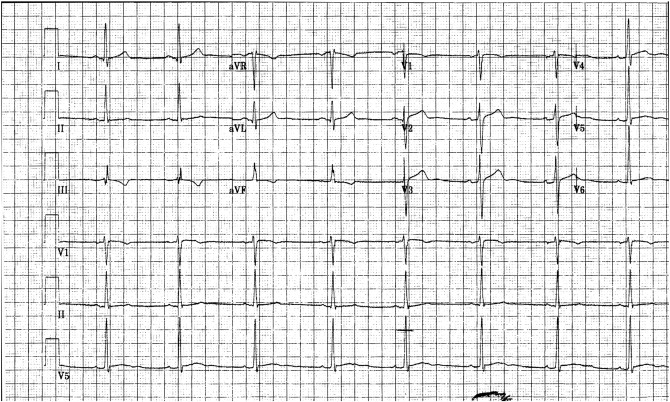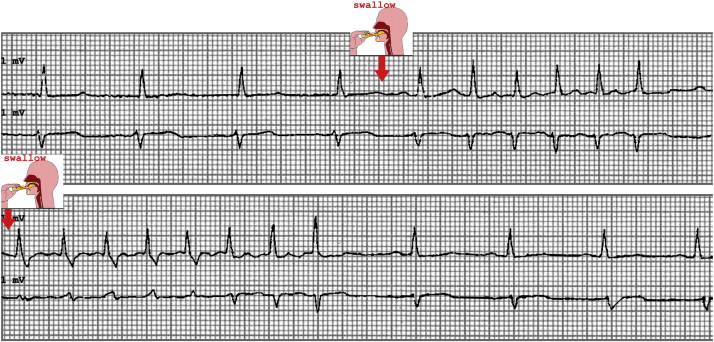Keywords
Swallowing-induced tachyarrhythmia;Supraventricular tachycardia;Atrial fibrillation;Flecainide
Swallowing-induced bradyarrhythmias due to vagal mechanisms have been well documented and are relatively commonplace. However, swallowing-induced tachyarrhythmia is an extremely rare syndrome of unclear etiology. We report a case of atrial fibrillation and SVT induced by swallowing solid foods and burping. Flecainide was prescribed with subsequent resolution of any inducible symptoms.
A 50-year-old Caucasian male with a history of paroxysmal SVT presented to the emergency department with a 3-day history of severe palpitations and lightheadedness, consistently associated with eating. The symptoms ceased spontaneously in less than thirty seconds after eating and occurred only with swallowing solid food. He described the palpitations as similar to his previous episodes of paroxysmal SVT, although more severe. He has also had mild palpitations starting a week before that were brought on by burping. He denied chest pain, nausea, vomiting, or diaphoresis. His past medical history was significant only for the SVT diagnosed six months earlier, adequately controlled on metoprolol. He had no history of heart disease or cardiac risk factors.
Physical examination, including the cardiac exam, was thoroughly unremarkable, with a blood pressure of 125/70 and pulse 68. There were no striking abnormalities in his resting ECG (Fig. 1). We were able to reproduce and document atrial fibrillation in the emergency department by observing his telemetry while he ate a sandwich (Fig. 2). Laboratory workup revealed normal routine studies. Transesophageal echocardiography demonstrated no structural or functional abnormalities. The patient was placed on 150 mg of flecainide B.I.D., with subsequent resolution of any inducible symptoms.
|
|
|
Fig. 1. Resting ECG: Sinus rhythm with ventricular rate of 55 bpm, PR interval 152 ms, QRS duration 86 ms, QTc 411 ms. |
|
|
|
Fig. 2. Telemetry showing atrial fibrillation every time the patient swallows food. |
Swallowing-induced tachyarrhythmia is a syndrome of unclear etiology that appears to affect predominately males over the age of 35 with no evidence of structural heart or esophageal problems [1]. It can often be frightening and debilitating. There have also been reports of self-limiting arrhythmias induced by stimulation of the upper gastrointestinal tract other than swallowing, such as belching [2] and coughing [3]. Among the reports, atrial fibrillation and atrial tachycardia are the most common induced arrhythmias [1].
There have been conflicting suggestions from various studies regarding the mechanisms of swallowing-induced tachyarrhythmias. Cohen et al. postulated mechanical stimulation of the left atrium by esophageal distention as the cause [4]. However, this has not been demonstrated to be consistently reproducible [5] ; [6]. Moreover, in many cases of reported swallowing-induced tachycardia, the arrhythmogenic origin was not found to be in physical close proximity to the esophagus. Vasovagal reflexes have also been proposed as a mechanism via preferential vagal stimulation of the atrial myocardium [5]. Cholinergic stimulation to the atrium has been shown to induce extrasystoles and atrial fibrillation in animal models [5], and it has been postulated that vagal stimulation non-uniformly shortens the relative refractory periods of atrial tissue, leading to reentrant circuits and abnormal beats [4]. Though this is a plausible theory, it has yet to explain why anti-cholinergic drugs fail to abolish the tachyarrhythmias [6]. Lastly, others have suggested an adrenergic reflex originating in the esophagus as the mechanism for swallowing-induced tachyarrhythmia. A sympathetic reflex can alter atrial depolarization and lead to focal reentry and atrial tachycardia. Although there have been some successful reports of anti-adrenergic medications use in swallowing-induced tachyarrhythmia, reports have been inconsistent [5].
Given the variations in the trigger and type of the arrhythmias, we suspect that the cause may differ in individual cases. Regardless of the mechanism of the induced arrhythmias, several months of Class Ia, Ic, and III anti-arrhythmics, B-blockers, and calcium channel blockers are generally effective in presumably permanently stopping the arrhythmias [6]. Newer techniques of radiofrequency catheter ablation of the arrhythmogenic source have also been attempted successfully on swallowing-induced tachyarrhythmias refractory to medical treatment [5].
References
- [1] H. Tada, K. Kaseno, S. Kubota, S. Naito, M. Yokokawa, S. Hiramatsu, et al.; Swallowing-induced atrial tachyarrhythmias: prevalence, characteristics, and the results of the radiofrequency catheter ablation; Pacing Clin Electrophysiol, 30 (2007), pp. 1224–1232
- [2] P.T. Wilmshurst; Tachyarrhythmias triggered by swallowing and belching; Heart, 81 (1999), pp. 313–315
- [3] I. Omori, C. Yamada, D. Inoue, H. Katsume, H. Ijichi; Tachyarrhythmia provoked by coughing and other stimuli; Chest, 86 (1984), pp. 797–799
- [4] L. Cohen, D.W. Larson, N. Strandjord; Swallowing-induced atrial fibrillation; Circulation, 42 (Suppl. II) (1970), pp. III–45
- [5] F. Morady, R.B. Krol, T.T. Nostrant, M. De Buitleir, W. Cline; Supraventricular tachycardia induced by swallowing: a case report and review of the literature; Pacing Clin Electrophysiol, 10 (1 Pt 1) (1987), pp. 133–138
- [6] J.G. Chock, M.R. Gill; Paroxysmal supraventricular tachycardia induced by oral stimulation: a case report and review of swallow-induced dysrhythmias; J Emerg Med, 22 (2002), pp. 389–392
Document information
Published on 19/05/17
Submitted on 19/05/17
Licence: Other
Share this document
Keywords
claim authorship
Are you one of the authors of this document?

